Themed collection Emerging Trends in MOFs

Interfacial effects on metal–organic frameworks for boosting electrocatalytic reactions
Recent advances in the distinctive interfacial effects of MOF-based heterogeneous catalysts for electrocatalytic reactions are comprehensively summarized in this review.

Chem. Commun., 2025,61, 8460-8470
https://doi.org/10.1039/D5CC02077H
Immunoadjuvant-functionalized metal–organic frameworks: synthesis and applications in tumor immune modulation
This review explores the synthesis, drug loading, and surface modifications of metal–organic frameworks (MOFs), highlighting their role in improving cancer immunotherapy and paving the way for safer and more effective treatments.

Chem. Commun., 2025,61, 1962-1977
https://doi.org/10.1039/D4CC06510G
Functional metal–organic frameworks derived electrode materials for electrochemical energy storage: a review
Pristine MOFs and their derivatives have been proven for supercapacitor as well as energy storage due to their versatile features like huge specific surface area, high porosity, redox active metal centre, high thermal stability, and so on.

Chem. Commun., 2024,60, 13292-13313
https://doi.org/10.1039/D4CC04086D
Unveiling the potential of MOF-based single-atom photocatalysts for the production of clean fuel and valuable chemical
Our highlight provides a comprehensive/insightful review on the achievement of combining a MOF and single atoms to generate high-performance photocatalysts for energy-related reactions.

Chem. Commun., 2024,60, 10989-10999
https://doi.org/10.1039/D4CC03479A
Photoresponsive metal–organic framework materials for advance applications
This highlight article aims to summarize different types of MOF materials and their strategies that cause them to exhibit photoresponsive behaviour.

Chem. Commun., 2024,60, 9149-9162
https://doi.org/10.1039/D4CC02093F
Interconversion and functional composites of metal–organic frameworks and hydrogen-bonded organic frameworks
This review describes the recent research on intercoversion and composites of metal–organic frameworks and hydrogen-bonded organic frameworks, along with their applications.

Chem. Commun., 2024,60, 8140-8152
https://doi.org/10.1039/D4CC01875C
Challenges and recent advances in MOF-based gas separation membranes
Schematic diagram of high performance gas separation membrane.

Chem. Commun., 2024,60, 7124-7135
https://doi.org/10.1039/D4CC02002B
Structural and compositional analysis of MOF-derived carbon nanomaterials for the oxygen reduction reaction
An in-depth analysis of the fundamental mechanism of MOF-derived carbon nanomaterials (MDCNM) for ORR promotion is presented through both the low-dimensional morphological structure and chemical composition.
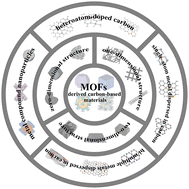
Chem. Commun., 2024,60, 2572-2590
https://doi.org/10.1039/D3CC05653H
Metal–organic frameworks in photocatalytic Z-scheme heterojunctions: an emerging technology
There is an urgent need for cleaner production processes for chemicals.
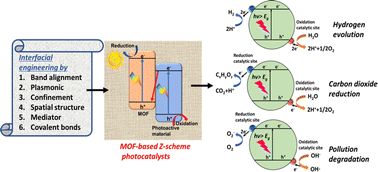
Chem. Commun., 2023,59, 3627-3654
https://doi.org/10.1039/D2CC05819G
Electrical bistability based on metal–organic frameworks
In this feature article, we focus on recent progress on MOF-based memristors and their switching mechanisms. In addition, challenges as well as future perspectives are discussed.
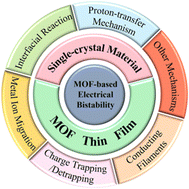
Chem. Commun., 2022,58, 9971-9978
https://doi.org/10.1039/D2CC03097G
Recent advances in metal–organic frameworks for catalysing organic transformation
Metal–organic frameworks (MOFs) provide a promising platform for organic transformations, owing to their abundant catalytic active sites. Herein, we summarized the recent advances and discussed the current challenges in this research area.

Chem. Commun., 2025,61, 7563-7572
https://doi.org/10.1039/D4CC06391K
Recent advances in continuous flow synthesis of metal–organic frameworks and their composites
Continuous flow synthesis offers a powerful approach for MOF & composite creation. This review explores its recent advancements, advantages over batch methods, & impact on MOF properties.

Chem. Commun., 2024,60, 8497-8515
https://doi.org/10.1039/D4CC02088J
Metal–organic framework based self-powered devices for human body energy harvesting
This article highlights the recent advancements in MOF-based materials for thermal or mechanical energy harvesting from the human body.

Chem. Commun., 2024,60, 7843-7865
https://doi.org/10.1039/D4CC02110J
Photomechanical properties in metal–organic crystals
This feature article aims to provide an authoritative view to understand the chemical aspects of the photosalient behavior of metal–organic crystals for further progress in this field of photoactuating smart materials.

Chem. Commun., 2024,60, 7555-7565
https://doi.org/10.1039/D4CC02655A
Metal–organic framework (MOF)-based materials for pyroptosis-mediated cancer therapy
This manuscript summarized the recent progress of MOF-based pyroptosis inducers in immunotherapy.

Chem. Commun., 2024,60, 6476-6487
https://doi.org/10.1039/D4CC02084G
Smart controlled-release nanopesticides based on metal–organic frameworks
Recent progress in smart controlled-release nanopesticides based on metal–organic frameworks toward hierarchical targets in response to multidimensional stimuli is highlighted to enhance pesticide efficacy.

Chem. Commun., 2024,60, 6082-6092
https://doi.org/10.1039/D4CC01390E
Recent advances in the fabrication of organic solvent nanofiltration membranes using covalent/metal organic frameworks
This review explores the promising role of COFs and MOFs in OSN membranes highlighting their potential for revolutionizing solvent separation and purification across crucial sectors like pharmaceuticals, petrochemicals, and environmental remediation.
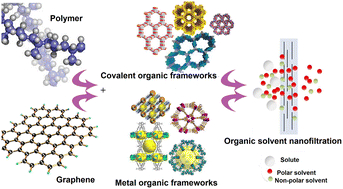
Chem. Commun., 2024,60, 2865-2886
https://doi.org/10.1039/D3CC06057H
Propagating MOF flexibility at the macroscale: the case of MOF-based mechanical actuators
Flexible Metal–Organic Framework (MOF) composites can be designed to develop shapeshifting materials in which the propagation of the dynamic behavior of flexible MOFs from the nano- or mesoscale to the macroscale results into useful mechanical work.
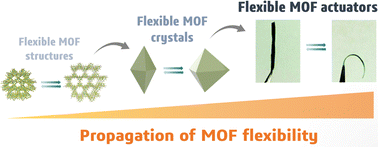
Chem. Commun., 2023,59, 1744-1756
https://doi.org/10.1039/D2CC05813H
Ionic metal–organic frameworks (iMOFs): progress and prospects as ionic functional materials
Summary of the design and synthesis of functional ionic metal–organic frameworks toward various energy and environmental applications.
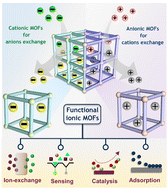
Chem. Commun., 2022,58, 13676-13698
https://doi.org/10.1039/D2CC05131A
Recent advances in the applications of porous organic cages
This mini-review summarises the recent advances in applications of porous organic cages, which derived from the unique features of this new sub-class of porous materials.
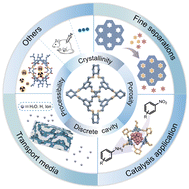
Chem. Commun., 2022,58, 11333-11346
https://doi.org/10.1039/D2CC03692D
Porous metal–organic frameworks for hydrogen storage
This article reviews the recent progress in the use of metal–organic frameworks as solid absorbents for hydrogen storage, and their current challenges and future prospects.
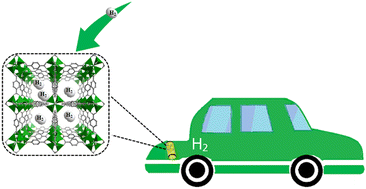
Chem. Commun., 2022,58, 11059-11078
https://doi.org/10.1039/D2CC04036K
Nanoparticle/metal–organic framework hybrid catalysts: elucidating the role of the MOF
This feature article highlights recent advances in hybrid catalysts of metal–organic frameworks (MOFs) and nanoparticles (NPs), focusing on the analysis of the interaction between NPs and MOFs and the reaction mechanisms.

Chem. Commun., 2022,58, 10757-10767
https://doi.org/10.1039/D2CC03233C
Luminescent MOFs (LMOFs): recent advancement towards a greener WLED technology
Luminescent MOFs (LMOFs) have demonstrated promise as alternative phosphors for energy efficient and environment friendly WLED technology. In this feature article, we outline the recent advancement toward greener WLED technology using REE-free LMOFs.
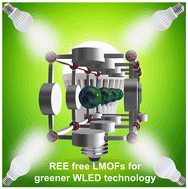
Chem. Commun., 2022,58, 10768-10788
https://doi.org/10.1039/D2CC03330E
Acetylenedicarboxylate as a linker in the engineering of coordination polymers and metal–organic frameworks: challenges and potential
Despite its simplicity as a short and rod-like linear linker, acetylenedicarboxylate has for a long time been somewhat overlooked in the engineering of coordination polymers and especially in the construction of metal–organic frameworks (MOFs).
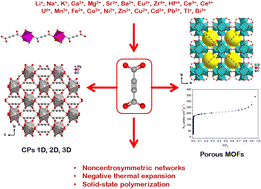
Chem. Commun., 2022,58, 8900-8933
https://doi.org/10.1039/D2CC02665A
Transformation of metal–organic frameworks with retained networks
The designed strategies for producing MOF-derived porous materials with preserved characters (framework skeletons, surface areas, porosity and properties) and improved stability are outlined.
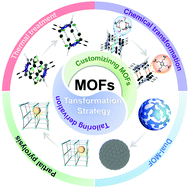
Chem. Commun., 2022,58, 8602-8613
https://doi.org/10.1039/D2CC02865D
Multi-functional metal–organic frameworks for detection and removal of water pollutions
This feature article reviews the recent achievements in metal–organic frameworks (MOFs) as versatile advanced materials for multifunctional water treatment and prospects the current challenges and the future research trends.
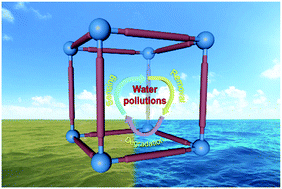
Chem. Commun., 2022,58, 7890-7908
https://doi.org/10.1039/D2CC02738K
Metalloporphyrinic metal–organic frameworks for enhanced photocatalytic degradation of a mustard gas simulant
A tin-porphyrin functionalized 2D metal–organic framework has been developed and exhibits one of the fastest rates for the photooxidative degradation of a mustard gas simulant.

Chem. Commun., 2025,61, 77-80
https://doi.org/10.1039/D4CC03890H
Monitoring of trace oxytetracycline using a porphyrin-MOF layer-based electrochemical aptasensor
A porphyrin-MOF nanolayer-based electrochemical aptasensor was constructed to detect trace oxytetracycline with high sensitivity, outstanding selectivity, good stability, and fine reproducibility.

Chem. Commun., 2024,60, 11584-11587
https://doi.org/10.1039/D4CC03645J
Pre-carbonized nickel–metal organic frameworks to enable lithium–sulfur reactions
The pre-carbonization treatment on Ni-MOF increases electron conductivity without structural collapse. Therefore, Ni-carbon not only preserves the polysulfide confinement ability of Ni-MOF but also propels direct Li2S nucleation/decomposition.

Chem. Commun., 2024,60, 11108-11111
https://doi.org/10.1039/D4CC03181D
Enhanced performance of dual-functional ZIF-8/red phosphorus photocatalysts for concurrent degradation of organic dyes and hydrogen generation under natural solar light irradiation
Herein, zeolitic imidazole framework (ZIF)-8/red phosphorus photocatalysts were prepared via a solvothermal method for simultaneous organic dye degradation and hydrogen (H2) generation.

Chem. Commun., 2024,60, 10970-10973
https://doi.org/10.1039/D4CC02644F
Structure-dependent magnetoelectric and magnetothermal effects of MOF-derived zero-valence cobalt and iron oxide nanoparticles on a carbonaceous matrix
Structure of MOF-derived metal nanoparticles and electrically conductive carbonaceous matrix dictates dominant magnetoelectric activity of ZIF-67-derived Co@C microparticles and distinctive magnetothermal effect of MIL-88B-derived Fe3O4:C microrods.

Chem. Commun., 2024,60, 10136-10139
https://doi.org/10.1039/D4CC03743J
Self-sacrifice template construction of a conductive Cu3(HHTP)2 nanowhisker arrays@copper foam toward robust lithium storage
Nanowhisker-like Cu3(HHTP)2 neat arrays grown on copper foam are rationally prepared via a self-sacrifice template avenue and exhibit high area capacity, good rate performance and cyclic stability as self-standing anodes for lithium storage.

Chem. Commun., 2024,60, 8423-8426
https://doi.org/10.1039/D4CC02052A
Modulated synthesis of hcp MOFs for preferential CO2 capture
The elevated density of μ2-OH bridging groups serves as the primary CO2 sorption site in hcp UiO-66, which is different from that in fcu UiO-66.

Chem. Commun., 2024,60, 8395-8398
https://doi.org/10.1039/D4CC01985G
Tuning the electronic properties of Zr UiO-66 through defect-functionalised multivariate modulation
Increasing porosity and tuning electronic properties through multivariate modulation.

Chem. Commun., 2024,60, 8280-8283
https://doi.org/10.1039/D4CC02581D
Construction of a redox-active metal–organic framework with an octanuclear lithium one-dimensional building block
We have synthesized a stable redox-active lithium-organic framework, constructed by Li8 cluster-based one-dimensional rod secondary building unit, demonstrating good stability, reversible redox activity, and can function as an electrochromic device.

Chem. Commun., 2024,60, 8047-8050
https://doi.org/10.1039/D4CC02111H
Amplification of negative gas adsorption in a multivariate framework
Tailoring of framework micromechanics using the multivariate MOF approach allowed stabilization of the metastable overloaded state and double the ΔnNGA value compared to original values in DUT-49.

Chem. Commun., 2024,60, 7886-7889
https://doi.org/10.1039/D4CC02540G
Chemical shaping of CPO-27-M (M = Co, Ni) through an in situ crystallization within chitosan hydrogels
CPO-27 MOF beads were prepared by an in situ crystallization approach with consequent increase of their maximal CO2 gravimetric uptake.

Chem. Commun., 2024,60, 7717-7720
https://doi.org/10.1039/D4CC02082K
2D metal–organic frameworks bearing butterfly-shaped metal-bis(dithiolene) linkers from dithiol-functionalized benzenedicarboxylic acid
2D metal-bis(dithiolene) frameworks can be achieved easily either by a stepwise protocol using a butterfly-shaped intermediate or by direct assembly using transition metal ions and 1,4-dicarboxylbenzene-2,3-dithiol.

Chem. Commun., 2024,60, 7578-7581
https://doi.org/10.1039/D4CC02282C
A bimetallic MOF-derived MnCo spinel oxide catalyst to enhance toluene catalytic degradation
Herein, MnCo spinel catalysts with large surface area were successfully prepared by using Mn/Co-MOFs as precursors for toluene catalytic degradation.

Chem. Commun., 2024,60, 7455-7458
https://doi.org/10.1039/D4CC01732C
Magnetocaloric efficiency tuning through solvent-triggered 3D to 2D interconversion in holmium(III)-based dynamic MOFs
Magnetothermal solvatoswitching in the family of holmium(III) sesquioxalate hydrates takes place through a crystalline-to-amorphous-to-crystalline 3D to 2D MOF structural transformation.

Chem. Commun., 2024,60, 7451-7454
https://doi.org/10.1039/D4CC02539C
Metal–organic framework/Nb4C3Tx MXene composites for ultrasensitive detection of dopamine
Composites with excellent performances for dopamine electrochemical sensing were prepared by in situ synthesis of metal–organic frameworks in presence of exfoliated Nb4C3Tx MXenes.

Chem. Commun., 2024,60, 7307-7310
https://doi.org/10.1039/D4CC00694A
Controllable construction of ZIF-derived Co9S8 hollow polyporous polyhedrons with Ru-doping for enhanced hydrogen evolution reaction
Ru-doped Co9S8 hollow porous polyhedrons derived from ZIFs possess superior HER performance.

Chem. Commun., 2024,60, 7069-7072
https://doi.org/10.1039/D4CC02074J
Modulation of copper sites in porphyrin metal–organic frameworks for electrochemical ascorbic acid sensing
This work realizes the regulation of the electrochemical ascorbic acid sensing performances of Cu porphyrin MOFs by modulation of the Cu-coordination structures through 4,4-bipyridine connection.

Chem. Commun., 2024,60, 6749-6752
https://doi.org/10.1039/D4CC01961J
Construction of a stable radical hydrogen-bonded metal–organic framework with functionalized tetrathiafulvalene linkers
We have designed a radical hydrogen-bonded metal–organic framework with an atomically-resolved single crystal structure, demonstrating excellent stability, good electrical conductivity, and highly efficient near-infrared photothermal conversion.

Chem. Commun., 2024,60, 5812-5815
https://doi.org/10.1039/D4CC01152J
Modulating confinement space in metal–organic frameworks enables highly selective indole C3-formylation
MOF confinement catalysis can hinder the reaction of orthoformate and indole to form the trimethoxymethane compounds, thereby creating indole C3 formaldehyde compounds.

Chem. Commun., 2024,60, 5715-5718
https://doi.org/10.1039/D4CC01629G
Hydrophobicity and dielectric properties across an isostructural family of MOFs: a duet or a duel?
Impedance spectroscopy measurements are combined with surface and pore hydrophobicity signatures to offer a new protocol for examining hydrophobic solids.
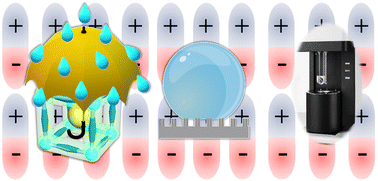
Chem. Commun., 2022,58, 12823-12826
https://doi.org/10.1039/D2CC04281A
Phase control of ZIF-7 nanoparticles via mechanochemical synthesis
MOF crystal phase control is made possible through a mechanochemical process.
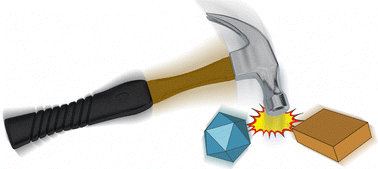
Chem. Commun., 2022,58, 12297-12300
https://doi.org/10.1039/D2CC04054A
Solid-state synthesis of a MOF/polymer composite for hydrodeoxygenation of vanillin
Here we demonstrate the use of a solid-state method to introduce a furan-thiourea polymer into the pores of a MOF, Cr-BDC.
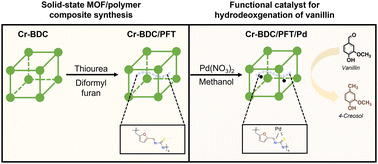
Chem. Commun., 2022,58, 11559-11562
https://doi.org/10.1039/D2CC03110H
Multivariate zeolitic imidazolate frameworks with an inverting trend in flexibility
Modulative adsorption behaviour with an inverting stepped adsorption pressure is observed in a family of multivariate flexible frameworks.
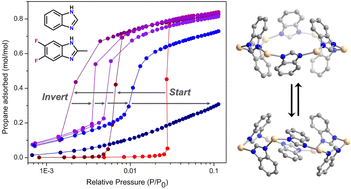
Chem. Commun., 2022,58, 11394-11397
https://doi.org/10.1039/D2CC04362A
Data-driven efficient synthetic exploration of anionic lanthanide-based metal–organic frameworks
The synthesis of lanthanide metal–organic frameworks with terephthalate (Ln-BDC-MOFs) was investigated using a data-driven approach.
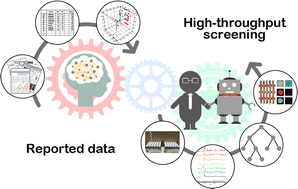
Chem. Commun., 2022,58, 11426-11429
https://doi.org/10.1039/D2CC04985F
Unravelling the synthesis of a rare-earth cluster-based metal–organic framework with spn topology
A novel rare-earth analogue of MOF-808 with 6-connected nodes is synthesized, shining light on the potential for open metal sites in rare-earth cluster-based MOFs.
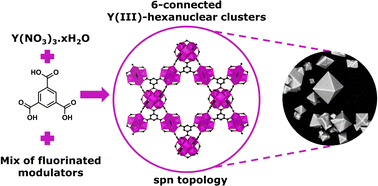
Chem. Commun., 2022,58, 10925-10928
https://doi.org/10.1039/D2CC03575H
Multi-layered ZIF-coated cells for the release of bioactive molecules in hostile environments
Living cells are coated with a multi-layered MOF biocomposite shell: the shell dissolution releases a biotherapeutic (antitrypsin) that provides artificial adaptability to protease-rich environments.

Chem. Commun., 2022,58, 10004-10007
https://doi.org/10.1039/D2CC03072A
Photoactive carbon monoxide-releasing coordination polymer particles
The size tunable Mn-based coordination polymer particles demonstrate the controlled carbon monoxide release triggered by light irradiation.
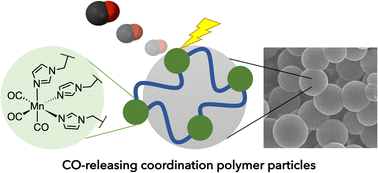
Chem. Commun., 2022,58, 9894-9897
https://doi.org/10.1039/D2CC03907A
Anionic or neutral? the charge of Ni8 cubes in metal–organic framework compounds
The cubic SBU Ni8X6L6 (X = OH−/H2O, L = ligand) in MOFs has so far been described as neutral in the literature. We investigated by detailed DRIFTS measurements and exchange reactions whether it shows anionic character, as observed in complexes.
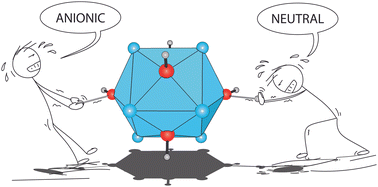
Chem. Commun., 2022,58, 9349-9352
https://doi.org/10.1039/D2CC03016K
Nitroxyl radical-containing flexible porous coordination polymer for controllable size-aelective aerobic oxidation of alcohols
A flexible TEMPO-PCP, whose pore conformation can be controlled through the choice of solvent, was developed as a size-selective catalyst for aerobic oxidation reactions.
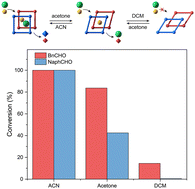
Chem. Commun., 2022,58, 9026-9029
https://doi.org/10.1039/D2CC02772K
Zr4+-terephthalate MOFs with 6-connected structures, highly efficient As(III/V) sorption and superhydrophobic properties
The utilization of terephthalate ligands with long alkyl chains resulted in the isolation of the first examples of Zr4+ terephthalate MOFs with 6-c frameworks, showing selective As(III/V) sorption and oil–water separation capability.
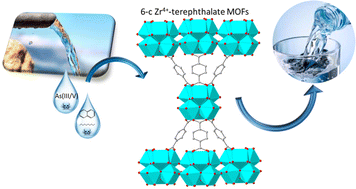
Chem. Commun., 2022,58, 8862-8865
https://doi.org/10.1039/D2CC03090J
Photoresponsive proton conduction in Zr-based metal–organic frameworks using the photothermal effect
A new zirconium-based MOF [Zr2(H4TPPP)(OH/F)2]·xH2O (1) is reported showing a prominent photothermal effect over a wide spectral range and photo-enhanced and switchable proton conductivity.
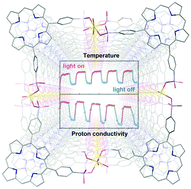
Chem. Commun., 2022,58, 8372-8375
https://doi.org/10.1039/D2CC02470E
Co-based metal–organic framework for photocatalytic hydrogen generation
Co-triazole MOF, obtained by facile hydrothermal synthesis, can be utilized as an efficient photo-driven catalyst in hydrogen production. The framework is highly robust and exhibits excellent activity, producing hydrogen of 9.32 mmol g−1 in 4 h.
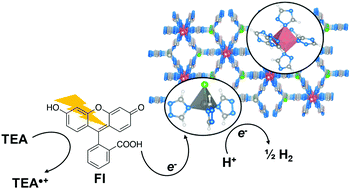
Chem. Commun., 2022,58, 8194-8197
https://doi.org/10.1039/D2CC02740B
Water vapour induced reversible switching between a 1-D coordination polymer and a 0-D aqua complex
The nonporous 1D coordination polymer [Zn(3-tba)2] (1β) undergoes water vapour-induced transformation to the 0D aqua complex [Zn(3-tba)2(H2O)2] (2). This phase transformation enables 1β to selectively adsorb water over alcohols under ambient conditions.

Chem. Commun., 2022,58, 8218-8221
https://doi.org/10.1039/D2CC02777A
Photochromic and electrochromic properties of a viologen-based multifunctional Cd-MOF
A novel multifunctional Cd-MOF possessing photochromic and electrochromic properties was constructed.
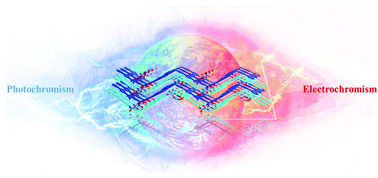
Chem. Commun., 2022,58, 7753-7756
https://doi.org/10.1039/D2CC02703H
A viologen-functionalized metal–organic framework for efficient CO2 photoreduction reaction
A viologen-functionalized metal–organic framework (MIL-125-RV2+) achieved CO2 reduction under visible light, which provided a strategy for the construction of novel CO2RR photocatalysts by combining color-tunable organics with framework materials.
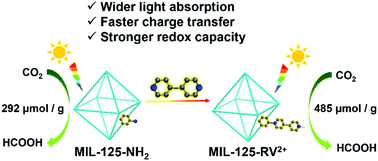
Chem. Commun., 2022,58, 7507-7510
https://doi.org/10.1039/D2CC02650C
Designed assembly of heterometallic zeolite-like framework materials from two different supertetrahedral metal clusters
By using two different supertetrahedral clusters as secondary building units, two new heterometallic zeolite-like frameworks were first made, demonstrating a feasible strategy for the synthesis of new functional framework materials.
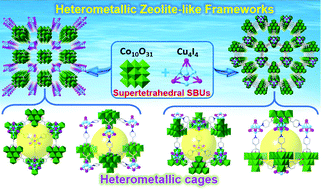
Chem. Commun., 2022,58, 6789-6792
https://doi.org/10.1039/D2CC01833K
Formaldehyde recognition through aminal formation in a luminescent metal–organic framework
Reticular synthesis of a pillar-layer metal–organic framework with a diamino-functionalized dicarboxylate as a pillar linker, realizing an exclusive luminescence response toward formaldehyde through aminal formation.
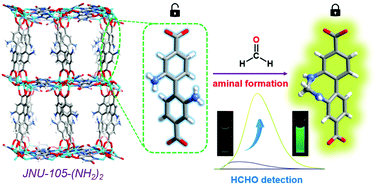
Chem. Commun., 2022,58, 6490-6493
https://doi.org/10.1039/D2CC02041F
Modulation of proton conductivity in coordination polymer mixed glasses
Mixed glasses from two meltable coordination polymers show composition dependent glass transition temperatures and a mixed-glass former effect on proton conductivity.
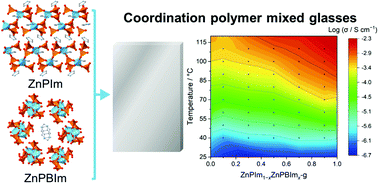
Chem. Commun., 2022,58, 6064-6067
https://doi.org/10.1039/D2CC01266A
Ethylene oxide functionalization enhances the ionic conductivity of a MOF
A synergistic approach, combining methods known to enhance solid-state conductivity, is applied here resulting in a true solid-state lithium conducting MOF system with ionic conductivity similar to reported MOF/Li salt/solvent electrolytes.
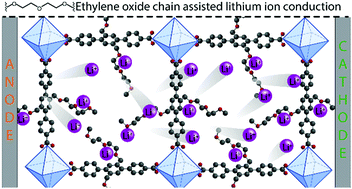
Chem. Commun., 2022,58, 5355-5358
https://doi.org/10.1039/D2CC01286C
Green-light-responsive metal–organic frameworks for colorectal cancer treatment
A novel green-light-responsive nanoMOF with low toxicity was developed as a drug delivery system. Our material demonstrates photo-controlled degradation, drug release, and cancer cell cytotoxicity.

Chem. Commun., 2022,58, 5225-5228
https://doi.org/10.1039/D2CC00591C
Exchange of coordinated carboxylates with azolates as a route to obtain a microporous zinc–azolate framework
A bistriazolate linker is exchanged for the carboxylate linker in Zn-MOF-74, tuning the coordination environment at the Zn(II) node and resulting in the novel NU-250 framework with hexagonal channels.
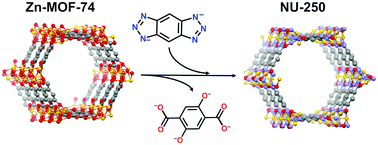
Chem. Commun., 2022,58, 4028-4031
https://doi.org/10.1039/D2CC00925K
About this collection
Discoveries of novel functional materials have played key roles in the development and progression of scientific research and technologies that consequently benefit our everyday life. Amongst diverse materials, metal-organic frameworks (MOFs) have emerged recently as one of the most promising class of advanced functional materials that have grown and evolved through fascinating academic interest toward real-world applications at industrial scale to advance current technologies in various areas such as energy-efficient gas separation and storage, environmental pollutant remediation, heterogeneous catalysis, optoelectronics, drug delivery etc.
This collection, guest-edited by Sujit K. Ghosh (IISER, India), Ilich A. Ibarra Alvarado (UNAM, Mexico) and Jing Li (Rutgers University, USA), highlights the recent advancements in the fundamental research (with an emphasis on structure-property correlation studies) and potential applications of MOFs along with the emerging research topics which promise to take the field to a new high.